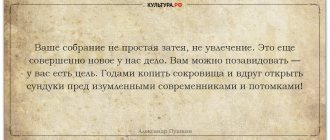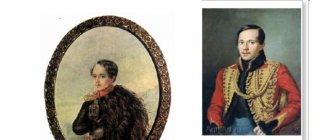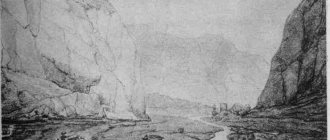Lermontov's works 6th grade
Lermontov's creativity
Completed by a student in grades 6-3
Teacher Volkova M.G.
Moskalenko Ilya
One of the most famous Russian poets, a “prophet” of the first half of the nineteenth century, who lived only twenty-seven years... But in this short period of time, he was able to convey in poetry everything that was seething in his soul.
M. Yu. Lermontov
Periods of creativity
Researchers and literary scholars divide Lermontov’s work into two periods. In short, this is the lyrical stage of formation, which lasted from 1828 to 1836, and maturity. The border between them was the death of Alexander Sergeevich Pushkin and the work “The Death of a Poet.” —
Youth creativity
The boy's first attempts to express his thoughts in the form of poetry date back to the age of fourteen. At this time, a “war” broke out in his family between the father, who saw his son’s talent and supported him in every possible way, and the grandmother, who sought to make the child a nanny for herself. The first poems are permeated with despair. These include sketches for "The Demon" and "Monologue". In addition to problems on the family front, the mood of the young poet is greatly influenced by the defeat of the Decembrists and the oppressive atmosphere that has developed in society. During the lyrical period, the young man becomes acquainted with Western European literature, especially becoming interested in the work of Byron. Therefore, in Lermontov’s poems, images of romantic heroes with a restless soul are born. They are independent, crave freedom, despise their surroundings and are in a state of eternal struggle with themselves.
Mature stage
The turning point is the death of Pushkin. It is this event that radically changes Lermontov’s work. This can be briefly expressed in one word - awakened. Now Mikhail Yuryevich realizes his destiny as a prophet and poet. Burn people's hearts with a verb. Show society the real situation that has developed throughout the Russian Empire. For this purpose, Lermontov leaves for the Caucasus, away from the emperor and his “minions.” The free and rebellious spirit of the poet opposes the current situation. He puts his experiences into the poems “The Prophet”, “The Death of a Poet”, “Borodino”, “Motherland” and others.
Dedicated to the memory of Pushkin
The poet is dead!
- a slave of honor - Fell, slandered by rumor, With lead in his chest and a thirst for revenge, Hanging his proud head!.. The poet's soul could not bear the shame of petty insults, He rebelled against the opinions of the world, Alone as before... and killed
!
Poet in the Caucasus
It is at the end of his life that the “civilian” Lermontov is born. Living in the Caucasus, he feels disappointment, loneliness, reflects deep thoughts and an accepted mission. Until his death, the poet develops the socio-political ideas of Pushkin, Belinsky, Chaadaev. In the work of his mature period, he raises questions about the fate of a generation, the tragedy of love, and tries to comprehend the place of poetry in the history of mankind.
The motive of the struggle
Lermontov's poetry is permeated with romantic motifs, ideas, and images. Lord Byron's influence on the young man lasted for the rest of his life.
The very first poems of M. Yu. Lermontov are imbued with heroism, suffering from the imperfection of the real world and the incomprehensibility of the poet’s aspirations.
The mood and experiences of the young man are especially fully
conveyed in three works - “Captive Knight”, “Prisoner” and “Sail”.
They are dominated by landscape and symbolic images.
For example, in “Sail” we see a reflection of internal events in the soul of the poet, who is trying to depict them with the help of a boat lost at sea.
Disappointment
The poet is tired of the endless and meaningless battle with his contemporaries, who do not want to hear his voice and wake up from mortal oblivion. Every line of the above-mentioned poems shines through with the desire to break out of the cage that Lermontov considered his life to be.
Like many other poems by M. Yu. Lermontov relating to the last years of his life, the works “In a difficult moment of life...”, “I go out alone on the road...” and “Both boring and sad” are permeated with calm and sadness.
He, as in his early teenage years, is still absent-minded, as if he was born completely at the wrong time.
These poems connect landscapes and the author’s inner feelings.
Lermontov's paintings about the Caucasus
Thank you for your attention
Presentation for an open lesson for 6th grade “Unknown M.Yu. Lermontov"
1 slide – painting “Sailboat at sea”. Music sounds (the sound of waves and the cry of seagulls)
Slide 2 – portrait of the poet.
Mikhail Lermontov was born in Moscow in 1814 into a noble family, lost his mother early and was raised by his grandmother. In 1825 E.A. Arsenyeva, Mikhail’s grandmother, took her grandson to the Caucasian waters, to Goryachevodsk (Pyatigorsk) for treatment. We rode our horses across all of Russia. The journey lasted three weeks. Misha saw Circassians in shaggy hats and burkas, horse races, fire dances, round dances, heard mountain songs, legends, stories. The Caucasus entered Lermontov's consciousness long before he reached poetic maturity and found himself in exile in this distant land. The great poet died in a duel in 1841.
3rd slide - painting by Lermontov M.Yu. with an image of a sailing ship at sea, 1832. The picture was painted by the poet for his poem. He conveyed in watercolors his first impressions of meeting the sea. The theme of the sea element, of free sail, then appears in many of Lermontov’s poems.
Slide 4 – graphic image of the troika.
The poet traveled a lot around Russia and therefore the theme of the road, the “Russian troika” is close to him. In many of his works there is Russian nature, Russian character, Russian soul...
Slide 5 – graphic sketch “The Horse is Free”. The sketch of the horse is anatomically correct and the dynamics are realistically conveyed. The flying, free horse personified free creative thought.
Slide 6 – graphic sketch “Officer on horseback and Amazon” 1840-1841, made by the poet for the chapter “Princess Mary”, the novel “A Hero of Our Time”. Lermontov's graphic drawings are a kind of commentary on the poet's literary intentions.
Slide 7 – Shocked by the death of my beloved poet A.S. Pushkin Lermontov writes incriminating poems against the autocracy “The Death of a Poet” in 1837, for which he will be exiled to the Caucasus and spend the last years of his life there.
Slide 8 – Episode from the Battle of Valerik on July 11, 1840.
If the painting depicts military actions, then this genre is called “Battle”. Lermontov was a wonderful battle painter, an exponent of the thoughts of his time, reflecting events in word and brush.
Slide 9 – “Under Valerik. July 12" (1840).
Slide 10 - “Pyatigorsk” (1837) Nature also endowed Lermontov with a genuine talent as a painter. His paintings are magnificent in color; they exude the spirit of Lermontov’s poetry.
Slide 11 - “Tiflis” (1837) The landscapes that Lermontov writes in haste, and on the basis of which he creates his paintings, turn out to be unusually close to his poetic descriptions.
Slide 12 – “Cross Mountain” (1838). As a child, the poet visited his relatives’ estate on the Terek in Pyatigorsk and saw the Caucasus mountains with his own eyes. Since that time, his favorite images: clouds, mountains, sea.
Slide 13 – “Georgian Military Road near Mtskheta” (1837-1838). Artists in those days did not travel to the Caucasus - it was fraught with dangers. Friends and acquaintances of Lermontov understood that the view of the Georgian military road sketched by the poet, lithographed and painted by him, was a wonderful gift.
Slide 14 – “Self-portrait” (1838). One of the most famous portraits of Lermontov. The poet is depicted against the backdrop of mountains in a burka draped over a jacket with Caucasian gazyrs. A Circassian saber is slung over his shoulder on a belt. A face with huge, sadly excited eyes, and although the features are irregular, the face is beautiful, inspired.
Slide 15 – Based on Lermontov’s poem “In the Wild North...” the great landscape painter I.I. Shishkin writes a wonderful picture “In the Wild North” (1890), which conveys the same feelings of loneliness and at the same time strength as in the lines of M.Yu. Lermontov.
Slide 16 – Based on Lermontov’s poem “The Demon,” the artist Vrubel paints the stunning painting “The Demon Seated” with its splendor. A handsome young demon with an athletic figure sits with a sad face and perhaps talks about the meaning of life.
Slide 17 – 200 years since the birth of the great poet, but the further time separates us from Lermontov, the closer he becomes to us.






